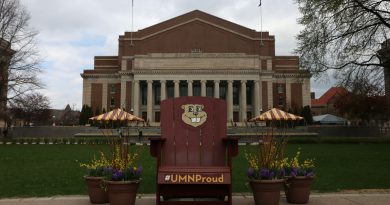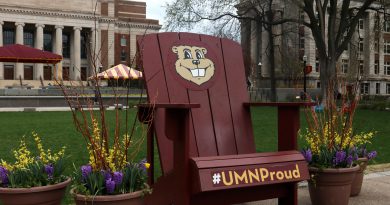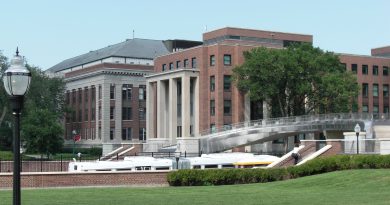Debunking – and “bunking”? – Myths at the University of Minnesota Twin Cities
Transitioning from high school to college can be a daunting process, with anxiety that can stem from changes in everything from lifestyle, to environment, to relationships, to academic demands.
For students with rural backgrounds, the prospect of going to a school in an urban setting can seem even more ominous. For those headed to the University of Minnesota’s Twin Cities campus, pre-college nerves about moving to a school with more than 50,000 students are fanned by myths about school and the new life that awaits them.
“It can be very daunting when you’re applying,” said Josh Kerkaert, who came to the university from Marshall, Minnesota, population 14,000, and graduated with a degree in microbiology.
Kerkaert said he recalled asking himself: “Do I really want to be just a number?”
But what are the most common myths that make the University of Minnesota—Twin Cities so intimidating? And, more importantly, are they true?
In other words, can AccessU: Beyond the Cities debunk, or “bunk,” these myths?
Here’s what five university students (and one almost student) from Greater Minnesota have to say about the wisdom—and silliness—of the common myths that enshroud the university.

Myth #1: Twin Cities and the University of Minnesota are overwhelmingly liberal
The Twin Cities swung overwhelmingly toward Democratic candidates in the 2018 midterm elections. But does this political preference show its face in everyday life?
Daniel Vermeer, a senior at the university studying professional journalism, said it certainly does.
“Going home and coming back to school was like going from one echo chamber to another,” Vermeer said.
The juxtaposing ideologies of the Twin Cities and his hometown, Pipestone, Minnesota, which has a population of 56,000, can be difficult to grapple with, he said Pipestone County voted for Republican candidates by nearly a 25 percent margin in the midterm elections.
The reason behind this political disconnect between conservative small towns and the large, mostly liberal Twin Cities is the product of a larger, visible cultural difference in how the two demographics see themselves. While many rural towns have a “nitty gritty,” “utilitarian” self-image, Vermeer said, the Twin Cities sees itself as a community that “enjoys the finer things in life.”
Liz Whippler, a junior studying Spanish and sociology of law, criminology and deviance, agreed that the political climate of the Twin Cities is much more liberal than her home, Parker’s Prairie, Minnesota, a town of 1,000.
She expected to feel a difference in political climate at the university, Whippler said, but she didn’t anticipate just how liberal the Twin Cities turned out to be.
This myth is: Bunked
Myth #2: In such a large community, you’re just a number
Due to its sheer size, the university offers social and cultural opportunities that smaller schools can’t. But can those numbers work against you?
For Karen Dolan, a 2013 graduate from St. Catherine’s University, the fear of getting lost in the shuffle of over 50,000 other students ultimately pushed her to choose a different college.
Dolan, from Tracy, Minnesota, population 1,800, considered studying at the University of Minnesota – Twin Cities with hopes of experiencing a “bigger, urban culture,” she said. When touring the university, however, she said she felt more attracted to St. Catherine’s intimate campus.
Even students who eventually chose the University of Minnesota agree that the size can make students feel like “just a number.” However, there are some upsides to this ‘small fish in a big pond’ feeling, Kerkaert said.
“In some ways it really set me up for where I am right now,” he said, describing how the anonymity of the university forced him to take responsibility for his own success. “I know some people who just did not work for and some people it really did.”
This myth is: Half-Bunked
Myth #3: The Twin Cities are more dangerous than greater Minnesota
In comparison to the rest of Minnesota, the Twin Cities are about as unsafe as they are liberal. Whether the higher crime rates translate to an overall more unsafe atmosphere depends, students said.
While Kerkaert was aware the Twin Cities is home to more crime than Marshall, “a small town where half the people don’t lock their doors,” he said he rarely felt urgently unsafe when at school.
Like Kerkaert, Dolan said she was acutely aware of the higher crime rates in the Twin Cities, and took precautions because of it. When she still lived in Minneapolis, Dolan said she walked more defensively than she does in rural Minnesota, always keeping her keys on hand for protection.
Sometimes, students do come face-to-face with crime, or at least the suggestion of it.
Dalton Uphoff, a junior at the university studying forestry and a native of Morris, Minnesota, population 5,300, said he’s encountered his fair share of “sketchy situations,” although none of them have ended poorly. Once, after giving a stranger a friendly “Midwestern nod” on public transit, Uphoff said he was offered an impressive array of drugs. Surprised, he turned the man down.
“I was just trying to be nice,” Uphoff said.
Since then, he said he’s learned to be less outgoing on public buses.
This myth is: Half-Bunked
Myth #4: Gay culture engulfs the cities and campuses
Where liberalism goes, gayness tends to follow. Or is it the other way around? Either way, students drawn to the Twin Cities for school are rumored to encounter both, and in great quantities.
When it comes to nightlife and campus climate, nothing could be more true, Vermeer said.
With a growing number of bars with official and unofficial gay seals of approval—like Ground Zero, Honey and Gay 90’s—the university and the Twin Cities themselves are a hub for gay life that new students are bound to notice when they arrive on campus, he said.
“Growing up… being anything other than the stereotype bread and butter, conservative, Christian person, you would keep quiet about it. When you get to the university it’s more ‘everybody can be who they want to be,’” Kerkaert said.
This myth is: Bunked


